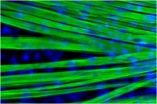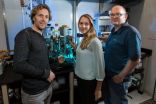New method reveals hidden population of regulatory molecules in cells
UC Santa Cruz researchers have revealed a previously undetected population of small RNA molecules involved in cell regulation
2015-08-03
(Press-News.org) A recently discovered family of small RNA molecules, some of which have been implicated in cancer progression, has just gotten much larger thanks to a new RNA sequencing technique developed by researchers at UC Santa Cruz.
The technique, described in a paper published August 3 in Nature Methods, provides sensitive detection of small RNAs that are chemically modified (methylated) after being transcribed from the genome. The researchers used the technique to reveal an abundance of modified fragments derived from transfer RNA molecules in both yeast cells and human cells.
"Transfer RNAs are some of the most numerous small RNAs in all organisms, and it turns out that cells are just littered with little pieces of them. We discovered that many of those pieces are hidden from the standard analyses due to modifications of the RNA," said first author Aaron Cozen, a project scientist in biomolecular engineering at UC Santa Cruz.
Senior author Todd Lowe, professor and chair of biomolecular engineering, said the method opens up a rapidly growing area of RNA research. "With our method, there is a more than three-fold increase in the overall detection of transfer RNA fragments," he said.
Transfer RNA was characterized decades ago and plays a well-defined role, together with messenger RNA and ribosomal RNA, in translating the genetic instructions encoded in DNA into proteins. The discovery of RNA interference and genetic regulation by microRNA, however, revolutionized scientists' understanding of RNA's role in gene regulation and other cellular functions. Since then, a bewildering abundance and variety of small RNA molecules has been found in cells, and scientists are still struggling to sort out what they all do.
"In the past five years, we're starting to see that transfer RNAs are not just translating genes into proteins, they are being chopped up into fragments that do other things in the cell," Lowe said. "Just recently, a subset of these fragments was found to suppress breast cancer progression."
Transfer RNA fragments can be detected and analyzed using high-throughput sequencing techniques. But a critical step in the RNA sequencing protocol is blocked by certain RNA modifications involving added methyl groups, and these modifications are prevalent in transfer RNAs. The UC Santa Cruz researchers and their collaborators at the University of Rochester School of Medicine developed an enzymatic method that removes those modifications before sequencing.
To make the method more powerful, the UCSC team developed a computational analysis of the sequencing data that they could use to identify and map specific modifications and see how common they are. They used this methodology to accurately predict previously documented transfer RNA modification patterns in yeast. Applying the technique to human cells, they were able to document a large number of previously unmapped modifications.
"In the human genome, this particular modification had only been mapped in 10 to 15 percent of transfer RNAs, and with our method were able to map pretty much all of them. It's greatly accelerating the pace of discovery," Lowe said.
Lowe noted that this project capitalized on the expertise at UC Santa Cruz in two major areas, RNA biology and genomics. His lab is affiliated with both the UC Santa Cruz Genomics Institute and the Center for Molecular Biology of RNA.
INFORMATION:
In addition to Cozen and Lowe, the coauthors of the paper include Andrew Holmes and Eva Robinson at UC Santa Cruz and Erin Quartley and Eric Phizicky at the University of Rochester School of Medicine. This research was supported by the National Institutes of Health.
ELSE PRESS RELEASES FROM THIS DATE:
2015-08-03
Skeletal muscle is one of the most abundant tissue types in the human body, but has proven difficult to produce in large quantities in the lab. Unlike other cell types, such as heart cells, neurons and cells found in the gut, previous attempts to efficiently and accurately derive muscle cells from pre-cursor cells or culture have not been fruitful. In a new study published this week in Nature Biotechnology, investigators from Brigham and Women's Hospital (BWH) report that by identifying and mimicking important developmental cues, they have been able to drive cells to grow ...
2015-08-03
LA JOLLA--T cells are the guardians of our bodies: they constantly search for harmful invaders and diseased cells, ready to swarm and kill off any threats. A better understanding of these watchful sentries could allow scientists to boost the immune response against evasive dangers (e.g., cancer or infections), or to silence it when it mistakenly attacks the body itself (e.g., autoimmune disorders or allergies).
Now, scientists at the Salk Institute have discovered that T cell triggering relies on a dynamic protein network at the cell surface, as reported in August 3, ...
2015-08-03
New brain research has mapped a key trouble spot likely to contribute to intellectual disability in Down syndrome. In a paper published in Nature Neuroscience [3 Aug], scientists from the University of Bristol and UCL suggest the findings could be used to inform future therapies which normalise the function of disrupted brain networks in the condition.
Down syndrome is the most common genetic cause of intellectual disability, and is triggered by an extra copy of chromosome 21. These findings shed new light on precisely which part of the brain's vast neural network contribute ...
2015-08-03
Greenhouse-gas emissions from human activities do not only cause rapid warming of the seas, but also ocean acidification at an unprecedented rate. Artificial carbon dioxide removal (CDR) from the atmosphere has been proposed to reduce both risks to marine life. A new study based on computer calculations now shows that this strategy would not work if applied too late. CDR cannot compensate for soaring business-as-usual emissions throughout the century and beyond, even if the atmospheric carbon dioxide (CO2) concentration would be restored to pre-industrial levels at some ...
2015-08-03
NEW YORK, NY (August 3, 2015) - Scientists at The New York Stem Cell Foundation (NYSCF) Research Institute successfully designed a revolutionary, high-throughput, robotic platform that automates and standardizes the process of transforming patient samples into stem cells. This unique platform, the NYSCF Global Stem Cell ArrayTM, for the first time gives researchers the scale to look at diverse populations to better understand the underlying causes of disease and create new individually tailored treatments, enabling precision medicine in patient care.
A paper published ...
2015-08-03
When it comes to making decisions involving others, the impression we have of their character weighs more heavily than do our assessments of how they can benefit us, a team of New York University researchers has found.
"When we learn and make decisions about people, we don't simply look at the positive or negative outcomes they bring to us--such as whether they gave us a loan or helped us move," explains Leor Hackel, a doctoral candidate in NYU's Department of Psychology and the study's lead author. "Instead, we often look beyond concrete outcomes to form trait impressions, ...
2015-08-03
Our brains are constantly barraged with sensory information, but have an amazing ability to filter out just what they need to understand what's going on around us. For instance, if you stand perfectly still in a room, and that room rotates around you, it's terrifying. But stand still in a room and turn your eyes, and the same visual input feels perfectly normal. That's thanks to a complex process in our brain that tell us when and how to pay attention to sensory input. Specifically, we ignore visual input caused by our own eye movements.
Now, researchers at The Rockefeller ...
2015-08-03
Skygazers at northern latitudes are familiar with the W-shaped star pattern of Cassiopeia the Queen. This circumpolar constellation is visible year-round near the North Star. Tucked next to one leg of the W lies a modest 5th-magnitude star named HD 219134 that has been hiding a secret.
Astronomers have now teased out that secret: a planet in a 3-day orbit that transits, or crosses in front of its star. At a distance of just 21 light-years, it is by far the closest transiting planet to Earth, which makes it ideal for follow-up studies. Moreover, it is the nearest rocky ...
2015-08-03
WASHINGTON, D.C. - Shifts in trade winds and ocean currents powered a resurgence of endangered Galápagos penguins over the past 30 years, according to a new study. These changes enlarged a cold pool of water the penguins rely on for food and breeding - an expansion that could continue as the climate changes over the coming decades, the study's authors said.
The Galápagos Islands, a chain of islands 1,000 kilometers (600 miles) west of mainland Ecuador, are home to the only penguins in the Northern Hemisphere. The 48-centimeter (19-inch) tall black and white ...
2015-08-03
PROVIDENCE, R.I. [Brown University] -- Even after centuries of earnest oaths and laws, the debate about whether money compromises medicine remains unresolved, observes Dr. Eli Adashi in a new paper in the AMA Journal of Ethics. The problem might not be truly intractable, he said, but recent reforms will likely make little progress or difference.
"This is one of those things we have to appreciate as being with us for a long time," said Adashi, former dean of medicine and biological sciences at Brown University. "It will probably be with us forever. It's probably not entirely ...
LAST 30 PRESS RELEASES:
[Press-News.org] New method reveals hidden population of regulatory molecules in cells
UC Santa Cruz researchers have revealed a previously undetected population of small RNA molecules involved in cell regulation


